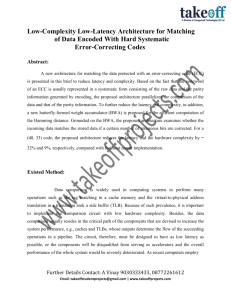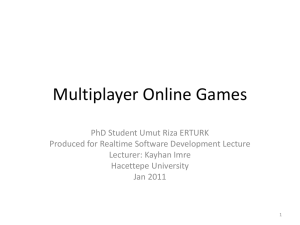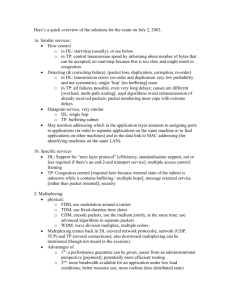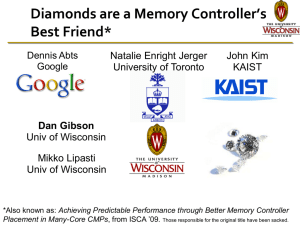slides - SyNRG
advertisement
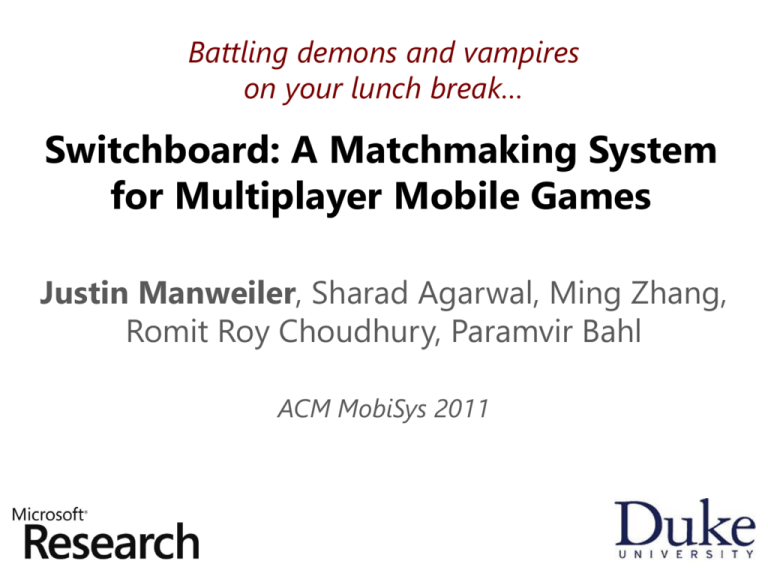
Battling demons and vampires on your lunch break… Switchboard: A Matchmaking System for Multiplayer Mobile Games Justin Manweiler, Sharad Agarwal, Ming Zhang, Romit Roy Choudhury, Paramvir Bahl ACM MobiSys 2011 Breakthrough of Mobile Gaming iPhone App Store 350K applications Time 20% apps, 80%47% downloads on Mobile Apps Spent Gaming Windows Phone 7 Top 10+ apps are games John Carmack (Wolfenstein 3D, Doom, Quake)… “multiplayer in some form is where the breakthrough, platform-defining things are going to happen in the mobile space” 2 Mobile Games: Now and Tomorrow Increasing Interactivity Single-player Mobile Multiplayer Turn-based Multiplayer Fast-action (mobile today) (mobile today) (mobile soon) 3 Key Challenge Bandwidth is fine: 250 kbps to host 16-player Halo 3 game Game Type Latency Threshold Delay bounds are much tighter First-person, Racing ≈ 100 ms Sports, Role-playing ≈ 500 ms Challenge: find groups of peers than can play well together Real-time Strategy ≈ 1000 ms 4 The Matchmaking Problem Connection Latency End-to-end Latency Threshold Match to satisfy total delay bounds Clients 5 Instability in a Static Environment Median Latency (ms) 310 290 270 Due to instability, must consider latency distribution 250 230 210 190 170 150 9:36 10:04 10:33 11:02 Time of Day (AM) 11:31 12:00 6 End-to-end Latency over 3G First-person Shoot. Racing Sports Real-time Strategy 1 Empirical CDF 0.8 Peer-to-peer reduces latency and is cost-effective 0.6 AT&T to AT&T Direct AT&T to AT&T via Bing AT&T to AT&T via Duke AT&T to AT&T via UW 0.4 0.2 0 0 100 200 300 RTT (in ms) 400 500 600 7 The Matchmaking Problem Targeting 3G: play anywhere Link Performance Latency not Bandwidth Measurement / Prediction interactivity is key at game timescales Grouping P2P Scalability 8 Requirements for 3G Matchmaking ● Latency estimation has to be accurate Or games will be unplayable / fail ● Grouping has to be fast Or impatient users will give up before a game is initiated ● Matchmaking has to be scalable For game servers For the cellular network For user mobile devices 9 State of the Art ● Latency estimation Pyxida, stable network coordinates; Ledlie et al. [NSDI 07] Vivaldi, distributed latency est.; Dabek et al. [SIGCOMM 04] Latency estimation and matchmaking ● Game matchmaking for wired networks are for wired networks Htrae, gameestablished matchmaking in wired networks; Agarwal et al. [SIGCOMM 09] ● General 3G network performance 3GTest w/ 30K users; Huang et al. [MobiSys 2010] Interactions with applications; Liu et al. [MobiCom 08] Empirical 3G performance; Tan et al. [InfoCom 07] TCP/IP over 3G; Chan & Ramjee [MobiCom 02] 10 A “Black Box” for Game Developers IP network Internet GGSN “Black Box” GGSN SGSN SGSN RNC RNC End-to-end Performance Crowdsourced Link Performance Measurement (over time) 11 Crowdsourcing 3G over Time Latency Similarity by Time Time 12 Crowdsourcing 3G over Space Latency Similarity by Distance 13 Can we crowdsource HSDPA 3G? ● How does 3G performance vary over time? How quickly do old measurements “expire”? How many measurements needed to characterize the latency distribution? Details of parameter space left for the paper … (our goal is not to identify the exact causes) ● How does 3G performance vary over space? Signal strength? Mobility speed? Phones under same cell tower? Same part of the cellular network? … 14 Methodology ● Platform Windows Mobile and Android phones HSDPA 3G on AT&T and T-Mobile ● Carefully deployed phones Continuous measurements Simultaneous, synchronized traces at multiple sites ● Several locations Princeville, Hawaii Redmond and Seattle, Washington Durham and Raleigh, North Carolina Los Angeles, California 15 Stability over Time (in a Static Environment) Redmond, AT&T, 15m Intervals 1 Empirical CDF 0.8 Live characterization is necessary and is feasible 0.6 Performance drifts over longer time periods 0.4 Similar latencies under the same tower Black line represents phone 1 (all other lines phone 2) 0.2 0 120 140 160 180 200 RTT (Msec) 220 240 16 Stability over Space (at the same time) Similarity at the same cell tower Substantial variation Divergence between nearby towers 1 Empirical CDF 0.8 0.6 S-home 0.4 Latona U Village 0.2 Herkimer Northgate 1st Ave 0 0 50 100 150 200 RTT difference at 90th percentile (ms) 17 Switchboard: crowdsourced matchmaking Switchboard Cloud Service Game on MSFT Azure Grouping Agent Network Testing Service Latency Data Measurement Controller Latency Estimator 18 Scalability through Reuse… ● Across Time Stable distribution over 15-minute time intervals ● Across Space Phones can share probing tasks equitably for each tower ● Across Games Shared cloud service for any interactive game 19 Client Matchmaking Delay 1 Empirical CDF 0.8 0.6 Switchboard clients benefit from deployment at scale 0.4 1 client arrival/sec Total 1 client/sec 0.2 10 client arrival/sec Total 10 clients/s 0 0 100 200 300 400 500 Time until placed in group (s) 600 700 20 Conclusion ● Latency: key challenge for fast-action multiplayer ● 3G latency variability makes prediction hard ● Crowdsourcing enables scalable 3G latency estimation ● Switchboard: crowdsourced matchmaking for 3G 21 Thank you! QUESTIONS? cs.duke.edu/~jgm jgm@cs.duke.edu 22 Mean Sequential Difference (ms) Stability over Time (in a Static Environment) 35 At timescales longer or shorter than 15 minutes: successive interval pairs have less similarity 30 25 20 15 95th 10 90th 50th 5 25th 0 0 50 100 150 Interval Size (in minutes) 200 250 23 How Many Measurements Req.? 1 0.9 Empirical CDF 0.8 0.7 5s 0.6 15s 0.5 45s 0.4 60s 0.3 90s 0.2 Reasonably small number of measurements are required per 15-minute interval 0.1 0 0 10 20 30 40 50 RTT difference at 90th percentile (in ms) 24 End-to-End Performance 1 0.9 Empirical CDF 0.8 End-to-end performance predictable as the sum of edge and Internet latencies 0.7 0.6 0.5 Durham FRH to San Antonio FRH 0.4 Durham phone to FRH 0.3 San Antonio phone to FRH 0.2 phone to phone 0.1 0 0 100 200 RTT (ms) 300 400 25 ICMP Probes by Client Arrival Rate 1 1 client/s Empirical CDF 0.8 2 clients/s 5 clients/s 0.6 10 clients/s More clients = less probing overhead for each 0.4 0.2 0 0 10 20 30 40 50 60 ICMP Probes per Client 26 Scalability by Client Arrival Rate Client-to-server Traffic (Kbps) 80 After the initial warming period, later clients reuse effort by earlier clients 70 60 50 40 30 1 client/s 2 clients/s 5 clients/s 10 clients/s 20 10 0 0 15 30 Time (minutes) 45 60 27 Group Size by Client Arrival Rate 1 1 client/s Empirical CDF 0.8 2 clients/s 0.6 5 clients/s 10 clients/s 0.4 Availability of high-quality matches increases with utilization 0.2 0 2 3 4 5 6 7 8 Size of Client Group 9 10 11 28 Timescale Statistical Analysis 1 240 minutes 0.9 120 minutes 0.8 60 minutes 2 minutes 15 minutes 0.7 0.6 0.5 0.4 0.3 0.2 Empirical CDF sig=90 α=0.1 0.1 0 0.00001 0.0001 0.001 0.01 0.1 1 KS Test P-Value (inter-interval instability where p < α), (log scale) 29


